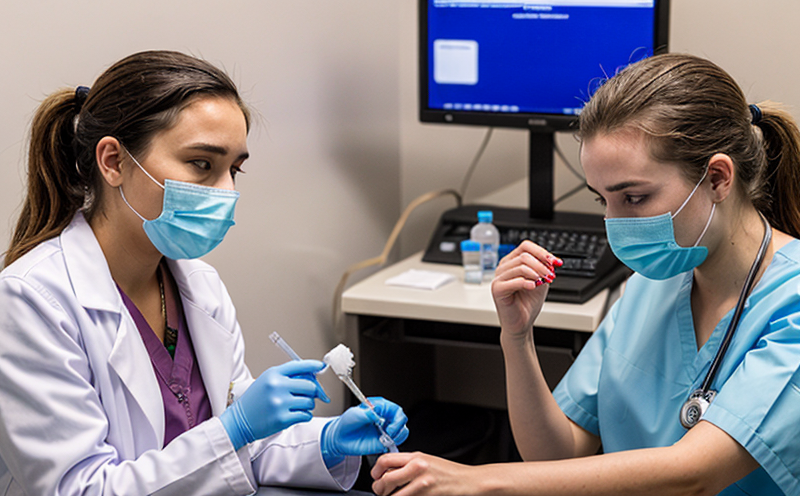ASTM E3246 Microbial Culture Verification Testing
The ASTM E3246 standard provides a method to verify that a microbial culture is correctly identified and can be used for diagnostic testing in clinical microbiology laboratories. This service ensures that the cultures are reliable, accurate, and suitable for the intended use. For quality managers, compliance officers, R&D engineers, and procurement personnel, this testing is crucial as it helps maintain the integrity of diagnostic processes.
Microbial culture verification involves several steps to ensure that the culture can be used correctly in diagnostic settings. First, the culture must be identified accurately using appropriate methods such as phenotypic tests or genotypic identification. Once the identity is established, the culture's performance is verified through a series of tests designed by ASTM E3246. These tests evaluate various aspects including growth characteristics, antibiotic susceptibility testing, and biochemical reactions.
Quality managers will benefit from this service as it helps them ensure that only reliable cultures are used in their laboratories. Compliance officers can use the results to demonstrate regulatory compliance with international standards like ISO 15189 or CLIA ’88. For R&D engineers, this testing ensures that new diagnostic tools and methods integrate seamlessly with existing laboratory workflows. Procurement teams will find this service valuable as it aids them in selecting suppliers who provide reliable cultures.
The ASTM E3246 standard also addresses the importance of maintaining a culture's stability over time. This is particularly critical for long-term storage or when cultures are shipped from one location to another. The testing process includes checks for viability and growth potential after extended periods. These parameters are essential for ensuring that cultures remain effective even if they need to be stored for an extended period.
In addition to the primary diagnostic use, cultures verified by ASTM E3246 can also be used in research settings. This standard ensures that any discrepancies between laboratory results and real-world outcomes are minimized, which is crucial for accurate scientific conclusions.
- Identify the microbial culture accurately
- Perform growth characteristic tests
- Conduct antibiotic susceptibility testing
- Evaluate biochemical reactions
The ASTM E3246 standard also emphasizes the importance of maintaining a culture's stability over time. This is particularly critical for long-term storage or when cultures are shipped from one location to another. The testing process includes checks for viability and growth potential after extended periods.
For quality managers, this service ensures that only reliable cultures are used in their laboratories. Compliance officers can use the results to demonstrate regulatory compliance with international standards like ISO 15189 or CLIA ’88. For R&D engineers, this testing ensures that new diagnostic tools and methods integrate seamlessly with existing laboratory workflows. Procurement teams will find this service valuable as it aids them in selecting suppliers who provide reliable cultures.
Applied Standards
The ASTM E3246 standard is widely recognized and used in clinical microbiology laboratories around the world. It ensures that microbial cultures are verified to meet strict quality standards, which is essential for maintaining diagnostic accuracy and reliability. Compliance with this standard is particularly important for laboratories aiming to achieve accreditation or certification under ISO 15189 or CLIA ’88.
The ASTM E3246 standard covers the verification of microbial cultures used in clinical diagnostics. It provides a comprehensive framework that includes steps for identification, growth characteristic tests, antibiotic susceptibility testing, and biochemical reaction evaluations. This ensures that only reliable cultures are used in diagnostic settings, which is critical for accurate and consistent results.
The ASTM E3246 standard emphasizes the importance of maintaining a culture's stability over time. This is particularly important for long-term storage or when cultures are shipped from one location to another. The testing process includes checks for viability and growth potential after extended periods, which helps ensure that cultures remain effective even if they need to be stored for an extended period.
International Acceptance and Recognition
- ASTM E3246 is widely accepted in the United States and Europe.
- The standard is recognized by numerous regulatory bodies, including FDA and European Medicines Agency (EMA).
- Compliance with ASTM E3246 ensures that laboratories meet international standards for clinical microbiology testing.
ASTM E3246 has gained significant acceptance in both the United States and Europe. Many countries have adopted this standard as a benchmark for ensuring the accuracy and reliability of microbial cultures used in diagnostic settings. Regulatory bodies such as the FDA and EMA recognize ASTM E3246, which further enhances its credibility.
Compliance with ASTM E3246 ensures that laboratories meet international standards for clinical microbiology testing. This is particularly important for laboratories seeking to achieve accreditation or certification under ISO 15189 or CLIA ’88. By adhering to this standard, laboratories can demonstrate their commitment to maintaining high-quality diagnostic practices.
Competitive Advantage and Market Impact
- ASTM E3246 helps labs stay ahead of regulatory requirements.
- The standard ensures consistent quality, which enhances lab reputation.
- Laboratories that comply with ASTM E3246 are more likely to attract clients seeking high-quality diagnostic services.
Adhering to the ASTM E3246 standard provides laboratories with a competitive edge in the market. By ensuring consistent quality, laboratories can enhance their reputation and attract clients who value high-quality diagnostic services. Compliance with this standard also helps labs stay ahead of regulatory requirements, which is essential for maintaining accreditation or certification under international standards like ISO 15189 or CLIA ’88.
Compliance with ASTM E3246 ensures that laboratories meet the stringent quality standards required in clinical microbiology testing. This not only enhances the reputation of the laboratory but also helps it stay competitive in a market where accuracy and reliability are paramount. Laboratories that comply with this standard are more likely to attract clients who trust their diagnostic services.





